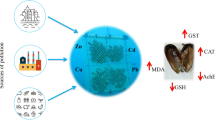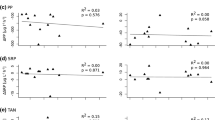Abstract
Groups of the mussel Perna perna were transplanted to two points and at three different depths in the coastal region close to the Itajaí-Açu River mouth, an impacted river in the south of Brazil. With the objective of evaluating the physiology changes in the organisms in relation to the control area (origin of the organisms), the clearance, respiration and excretion rates, absorption efficiency and growth were estimated. The levels of metals in the organism tissue were determined in an attempt to explain the physiological changes occurring in the study area. Organisms from Point 2 placed near the bottom showed physiological changes in comparison to the control and the transplanted organisms from Point 1. Point 2 showed greater sediment resuspension and availability of trace metals to the organisms closer to the bed. The increase in Cr concentration in the tissues of the organisms (up to 0.21 mg kg−1 ww) was not sufficient to explain the decrease in the inhibition of clearance (28.8%) and in the absorption efficiency (15.7%), or the increased excretion rate (282.5%), which led to the organisms having a reduced scope for growth (48.6%). This indicates the possible presence of other contaminants, which were not measured, and which probably had synergistic action with the trace metals investigated.

Similar content being viewed by others
References
Bayne BL, Brown DA, Burns K, Dixon DR, Ivanovici A, Livingstone DR, Lowe DM, Moore MN, Stebbing ARD, Widdows J (1985) The effects of stress and pollution on marine animals. Praegez Publshers, New York
Bellotto VR, Francioni E (2008) Capítulo 13—Níveis de metais e sua aplicação na análise e monitoramento ambiental. In: Resgalla C Jr, Weber LI, Conceição MB (eds) O mexilhão Perna perna: Biologia, Ecologia e Aplicações. Editora Interciência, Rio de Janeiro, pp 207–235
Carvalho JLB, Schettini CAF, Ribas TM (1998) Estrutura termohalina do litoral centro-norte catarinense. Notas Téc FACIMAR 2:181–197
Clements WH, Kiffney PM (1994) Integrated laboratory and field approach for assessing impacts of heavy metals at the Arkansas River, Colorado. Environ Toxicol Chem 13:397–404
Gommersbach VB (2000) Monitoramento da qualidade da água em rios a partir de imagens orbitais. Estudo de caso: rio Itajaí-açu. MSc. Dissertation. Fundação Universidade de Blumenau, Brazil
Greenberg AE, Clesceri LS, Eaton AD (1992) Standard methods for the examination of water and wastewater. APHA, Washington
Laitano K, Resgalla C Jr (2000) Uso de testes de toxicidade com larvas de Arbacia lixula e juvenis de Metamysidopsis elongata atlantica na avaliação da qualidade do sedimentos dos rios Camboriú e Itajaí-Açú (Santa Catarina). In: Espíndola G, Botta Paschoal CMR, Rocha O et al (eds) Ecotoxicologia. Perspectivas para o século XXI. Rima Editora, São Carlos, pp 29–42
Martin M, Ichikawa G, Goetzl J, Reyes M, Stephenson MD (1984) Relationships between physiological stress and trace toxic substances in the Bay Mussel, Mytilus edulis, from San Francisco Bay, California. Mar Environ Res 11:91–110
Omori M, Ikeda T (1984) Methods in marine zooplancton ecology. John Wiley, New York
Pereira Filho J, Spillere LC, Schettini CAF (2003) Dinâmica de nutrientes na região portuária do estuário do rio Itajaí-Açú, SC. Atlântica 25:11–20
Pessatti M, Resgalla C Jr, Reis Filho RW, Kuehn J, Salomão LC, Fontana JD (2002) Variability of filtration and food assimilation rates, respiratory activity and multixenobiotic resistance (MXR) mechanism in the mussel Perna perna under lead influence. Braz J Biol 62(4):651–656
Rand GM (1995) Fundamentals of aquatic toxicology. Effects, environmental fate and risk assessment. Taylor & Francis, Washington
Resgalla C Jr, Schettini CAF (2006) Características e variação do seston da enseada da Armação do Itapocoroy, Penha, SC. In: Branco JO, Marenzi AWC (eds) Bases ecológicas para um desenvolvimento sustentável: estudos de caso em Penha. SC. Editora UNIVALI, Itajaí, pp 107–120
Resgalla C Jr, Moraes RBC (2008) Capítulo 15—uso em ensaios ecotoxicológicos. In: Resgalla C Jr, Weber LI, Conceição MB (eds) O mexilhão Perna perna: biologia, ecologia e aplicações. Editora Interciência, Rio de Janeiro, pp 253–268
Resgalla C Jr, Brasil ES, Salomão LC (2006) Physiological rates in different classes of sizes of Perna perna (Linnaeus, 1758) submmited to experimental laboratory conditions. Braz J Biol 66:325–336
Resgalla C Jr, Brasil ES, Salomão LC (2007a) The effect of temperature and salinity on the physiological rates of the mussel Perna perna (Linnaeus 1758). Braz Arch Biol Technol 50:543–556
Resgalla C Jr, Brasil ES, Salomão LC (2007b) Efeito da concentração e da qualidade do alimento nas taxas fisiológicas do mexilhão Perna perna (Linnaeus, 1758). Atlântica 29:47–59
Rörig LR (2005) Uso múltiplos e qualidade das águas da bacia do baixo Itajaí-açu, SC. Elementos para um gerenciamento integrado. PhD thesis, Universidade Federal São Carlos, Brazil
Schettini CAF (2002) Caracterização física do estuário do rio Itajaí-açu, SC. Rev Bras Recursos Hídricos 7(1):123–142
Schettini CAF, Toldo EE Jr (2006) Fine sediment transport modes in the Itajaí-Açu estuary, southern Brazil. J Coastal Res 39 (SI):515–519
Schettini CAF, Kuroshima KN, Pereira Filho J, Rörig LR, Resgalla C Jr (1998) Oceanographic and ecological aspects of the Itajaí-Açu River plume during a high discharge period. An Acad Bras Ciênc 70(2):335–351
Schettini CAF, Carvalho JLB, Truccolo EC (1999) Aspectos hidrodinâmicos da enseada da Armação do Itapocoroy, SC. Notas Téc FACIMAR 3:99–109
Schettini CAF, Resgalla C Jr, Pereira Filho J, Silva MAC, Truccolo EC, Rörig LR (2005) Variabilidade temporal das características oceanográficas e ecológicas da região de influência fluvial do rio Itajaí-Açu. Braz J Aquatic Sci Technol 9(2):93–102
Schettini CAF, Ricklefs K, Truccolo EC, Golbig V (2006) Synoptic hydrography of a highly stratified estuary. Ocean Dyn 56(3–4):308–319
Smaal AC, Widdows J (1994) Chapter 2—the scope for growth of bivalves as an integrated response parameter in biological monitoring. In: Kramer KJM (ed) Biomonitoring of coastal waters and estuaries. CRC, Boca Raton, pp 247–267
Strickland JDH, Parsons TR (1972) A practical handbook of seawater analysis. Bull Fish Res Board Canada 167:310
Trochimczuk A, Schettini CAF (2003) Avaliação da dispersão especial da pluma do estuário do Rio Itajaí-Açu em diferentes períodos de descarga. Notas Téc Facimar 7:83–96
Watling HR, Watling RJ (1982) Comparative Effects of Metals on the Filtering Rate of the Brown Mussel (Perna perna). Bull Environ Contam Toxicol 29:651–657
Widdows J, Johnson D (1988) Physiological energetics of Mytilus edulis: scope for growth. Mar Ecol Prog Series 46:113–121
Widdows J, Donkin P (1992) Chapter 8—mussel and environmental contaminants: bioaccumulation and physiological aspects. In: Gosling E (ed) The mussel Mytilus edulis: ecology, physiology, genetics and culture. Elsevier, Amsterdam, pp 383–424
Widdows J, Nasci C, Fossato U (1997) Effects of pollution on the scope for growth of mussels (Mytilus galloprovincialis) from the Venice lagoon, Italy. Mar Environ Res 43(1/2):69–79
Zar JH (1996) Biostatistical analysis. Prentice Hall, New Jersey
Acknowledgments
The study was partially funded by Fundação de Amparo a Pesquisa de Santa Catarina—FAPESC, through the project ITAPLA—Interactions between the Itajaí-Açu estuary and adjacent shelf, and its implications in terms of coastal evolution and biological productivity. We would also like to thank the Conselho Nacional de Desenvolvimento Científico e Tecnológico (National Research Council; CNPq) for the Grants 302165/2008-8 C. Resgalla; 300898/2007-0 CM Radetski and 306217/2007-4 CAF Schettini.
Author information
Authors and Affiliations
Corresponding author
Rights and permissions
About this article
Cite this article
Resgalla, C., Radetski, C.M. & Schettini, C.A.F. Physiological energetics of the brown mussel Perna perna (L.) transplanted in the Itajaí-Açu river mouth, Southern Brazil. Ecotoxicology 19, 383–390 (2010). https://doi.org/10.1007/s10646-009-0422-2
Accepted:
Published:
Issue Date:
DOI: https://doi.org/10.1007/s10646-009-0422-2




